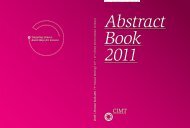Abstract Book 2010 - CIMT Annual Meeting
Abstract Book 2010 - CIMT Annual Meeting
Abstract Book 2010 - CIMT Annual Meeting
You also want an ePaper? Increase the reach of your titles
YUMPU automatically turns print PDFs into web optimized ePapers that Google loves.
099 Hemmerling | Tumor biology & interaction with the immune system<br />
Human Langerhans cells reconstitute in skin xenografts<br />
Julia Hemmerling 1 , Joanna Wegner-Kops 1 , Diana Wolff 1 , Maria Sommer 1 , Eva M. Wagner 1 ,<br />
Esther von Stebut 2 , Udo F. Hartwig 1 , Rudolf E. Schopf 2 , Matthias Theobald 1 , Wolfgang<br />
Herr 1 , Ralf G. Meyer 1<br />
1 Department of Hematology/Oncology and<br />
2 Department of Dermatology, at the University Medical Center of the Johannes Gutenberg-University<br />
Mainz, Germany<br />
148<br />
Dendritic cells (DC) of the skin, e.g. epidermal Lan-<br />
gerhans cells (LC), are potent regulators of T cells.<br />
They therefore are interesting targets for autologous<br />
T-cell stimulation in the context of vaccinestrategies<br />
as well as for the manipulation of allo-reactive<br />
T-cells in graft-versus-host disease (GVHD).<br />
In an attempt to study the biology of human LC in<br />
vivo, we transplanted human skin to immunodeficient<br />
NOD/SCID/γcnull (NSG) mice and studied the<br />
impact of xeno-transplantation on the distribution<br />
of LC in comparison to that of CD11c positive dermal<br />
DC. We analyzed skin xenografts at different time<br />
points after transplantation and found that during<br />
wound healing, LC were absent in grafts prepared<br />
4 to 6 weeks after transplantation. However, in<br />
many animals analyzed beyond week 6, LC were<br />
again present with almost normal distribution.<br />
These findings were re-confirmed by staining with<br />
antibodies against human CD1a, CD207/Langerin,<br />
S100 and HLA-DR. CD11c positive human dermal<br />
cells were also transiently reduced in numbers, but<br />
never vanished from the dermis after xenografting.<br />
In subsequent experiments, we analyzed the skin<br />
grafts by sequential biopsies and again demonstrated<br />
that more than 50 % of the skin grafts were<br />
devoid of LC in week 6. Three to 5 weeks later,<br />
LC were detected again in these transplants with a<br />
slightly reduced density compared to normal skin.<br />
In congenic mouse models of hematopoietic stem<br />
cell transplantation, murine LC have been shown<br />
to re-populate after local skin injury without the<br />
need of blood-derived precursors. Up to now, there<br />
are only few data supporting this hypothesis for<br />
human LC. By demonstrating the re-establishment<br />
of LC in the xenografts in the absence of any human<br />
hematopoiesis, our data confirm that human LC are<br />
able to re-populate the skin after local depletion.<br />
We further analyzed the proliferative activity of<br />
LC in the xenografts by double staining of CD207/<br />
Langerin-positive cells with Ki67 and found a significantly<br />
increased proliferative activity of LC<br />
compared to healthy skin (31% vs. 5%). Proliferation<br />
is a unique feature of LC among DC. Our data<br />
suggest that this contributes to LC-reconstitution.<br />
In summary, we introduce a human skin xenograftmodel<br />
that allows studying the biology of LC and<br />
dermal DC. Our findings help to unravel the phenomenon<br />
of local LC-reconstitution in human skin.<br />
This model might also help to study the role of skin<br />
DC for inflammatory skin disease and skin GVHD<br />
as well as for vaccine-strategies in vivo.



